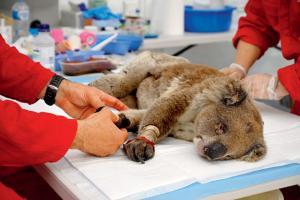This has contributed to environmental degradation, leading to the emergence of zoonotic diseases such as COVID-19, according to WWFs Living Planet Report, 2020

A koala being treated for burns at a field hospital at the Kangaroo Island Wildlife Park. Pic/aFP
Global populations of mammals, birds, amphibians, reptiles and fish have suffered an average two-thirds' decline in less than half a century. This has contributed to environmental degradation, leading to the emergence of zoonotic diseases such as COVID-19, according to WWF's Living Planet Report, 2020.
ADVERTISEMENT
The Living Planet Index (LPI) shows that the factors believed to increase the planet's vulnerability to pandemics, including land-use change and the use and trade of wildlife, were also some of the drivers behind the 68 per cent average decline in global vertebrate species population between 1970 and 2016.
"The Living Planet Report, 2020 underlines how humanity's increasing destruction of nature is having catastrophic impact not only on wildlife populations, but also on human health and all aspects of our lives," said Marco Lambertini, Director General, WWF International. "Our planet is flashing red-warning signs of system failure," he added.
Keep scrolling to read more news
Catch up on all the latest Crime, National, International and Hatke news here. Also download the new mid-day Android and iOS apps to get latest updates.
Mid-Day is now on Telegram. Click here to join our channel (@middayinfomedialtd) and stay updated with the latest news
This story has been sourced from a third party syndicated feed, agencies. Mid-day accepts no responsibility or liability for its dependability, trustworthiness, reliability and data of the text. Mid-day management/mid-day.com reserves the sole right to alter, delete or remove (without notice) the content in its absolute discretion for any reason whatsoever
 Subscribe today by clicking the link and stay updated with the latest news!" Click here!
Subscribe today by clicking the link and stay updated with the latest news!" Click here!







